Items Tabs
The Title section remains visible no matter what tab you are on, allowing you to edit the cover art, title, author, and call number on the go. It also indicates the title’s media (upper right corner) and provides copy information (bottom right, click to access the copy list dialog).

Cover Art
The item picture field. Hover over the cover art to see the picture options (add, remove, or change how it checks for cover art). To add an item picture, upload a GIF, BMP, PIC, JPG, PNG (or any other standard image file) by clicking the plus + icon on the cover art, or copy+paste an image. There is a 250kb size limit for uploaded images.
Title
This is a required field; the record will not be saved unless a Title value is entered. The title is saved under MARC field 245_a.
Author
This is the primary author saved in MARC tag 110_a or 111_a; enter the author’s name in “Last Name, First Name” format. To add/edit additional authors, use the MARC View editor and add them as repeating 700_a or other appropriate tags.
Call Number
Each title is assigned a call number; saved in MARC field 900_a. The call number designates the location of an item in the library. Because call numbers are site-specific rather than universal (such as LCCN and ISBN), you must enter call numbers that are specific to your library. Depending on their source, imported MARC records may or may not include a call number for your items. Copies will “inherit” the title call number unless a specific copy call number is changed.
Call Number Formatting
There are different ways to structure your physical library and, consequently, set up your call numbers. Call numbers are like addresses; they indicate where patrons can find items in your library. Dewey Decimal and Library of Congress are common classifications.
Another increasingly popular way to organize your library is by genre. And it’s common for genrefied libraries to use a combination of genre and author last name as call numbers; often these are abbreviated. For example, with a call number of FIC SHU, FIC would be short for the genre—fiction—and SHU would be short for the author’s last name—Shusterman.
Call number sections in Alexandria can be separated by spaces and/or periods. Here are some examples of call numbers that work in Alexandria:
- FIC CHR
- 327.67 DEE
- 355 SIE
When printing spine labels, you can choose whether to split sections where there are spaces or spaces & periods.
Alexandria formats call numbers to remove control characters and double spaces, thus correcting incorrectly formatted numbers. If you’d like to keep
double spaces in your call numbers, use the “fixed space” character.
Clean up your call numbers and other data with our Mitinet services!
See Item Editors to learn more about editing the Title, Author, and Call Number fields.
 | Are you cataloging ebooks or equipment? Here are some resources! Cataloging Best Practices, Cataloging eBooks |
Publication
The fields in the Publication tab are used to supply title-specific publication information.
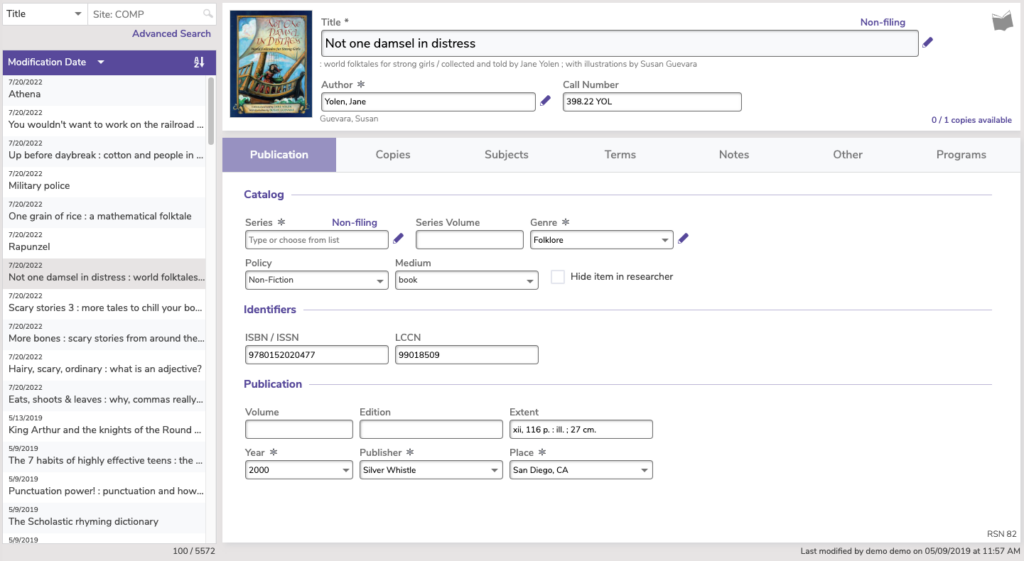
Catalog
Series
This authority controlled field allows you select from pre-existing Series or enter a new one! See Item Editors.
Non-Filing
The Non-Filing drop-down menu allows you to specify terms (less than eight characters long) in the title to ignore when indexing the series. Thus, if your series is “The Chronicles of Narnia”, you can select The from the Non-Filing drop-down menu so the series is sorted (indexed) as “Chronicles of Narnia”. Alexandria will also ignore following spaces or punctuation characters.
Series Volume
This field holds the volume number of the series and stores the information in the 830_v MARC tag. You may have more than one 830 tag for each title if your system provides both chronological and release order information or if the series is part of another series.
Genre
The genre authority controlled field groups items with similar characteristics according to popular subjects at the time. A good example is the Firefly TV series, which fits under both Western and Science Fiction. Set the most relevant genre for your account here and add more genre tags as needed in the MARC View Editor with the 655_a MARC field. See Item Editors.
Policy
The item policy determines the circulation rules for a particular group of items. Every title is given a policy. In addition to enforcing circulation rules, an item’s policy is used to group items for statistical analyses and reporting purposes. Copies will “inherit” the title policy unless a specific policy is assigned. Electronic resources will show an (O). See Tools > Policies.
Medium
The medium indicates the “media type” and/or physical characteristics of the item; for example, biography, essay, reviews, journal, diary, etc. This drop-down menu lets you choose from existing mediums that have been used so far in your library. The default is Book. You can create a new medium by saving a new 245_h MARC field in the MARC View editor. If you would like to remove a medium from this list, you must replace the unwanted “media type” in all records that use it; it will then completely disappear as a selection.
Hide item in researcher
Use this checkbox if you don’t want the title to appear in your Researcher results when a patron performs a search, such as equipment or teacher materials. This setting applies to all copies across all collections in a database. Show teachers how to find hidden items by pressing Option / Alt on your keyboard while hitting the Return key as you conduct a search!
 | You can also search for hidden items by adding && (hidetitle::1) to a search string. For example, to search for projectors, you would type ((smart::projectors) && (hidetitle::1)). |
Identifiers
ISBN/ISSN
Enter the item’s International Standard Book Number; saved in MARC field 020_a. The ISBN is a unique identifier. A title may have more than one ISBN (e.g., the ISBN for the hardback edition differs from the paperback edition). Alexandria only displays the first ISBN found in the MARC record. You can enter an ISSN rather than an ISBN. If the number you enter is 8 digits, Alexandria assumes the number is an ISSN and saves it at MARC tag 022_a. If it has 10 digits, Alexandria assumes it is an ISBN. Note that a SmartMARC Update looks at the first ISBN, so put the best one first. Enter the item’s Library of Congress Control Number.
 | If you enter an invalid ISBN number, a question mark (?) appears at the beginning of the number to indicate that it is not valid. Any punctuation, dashes, or spaces are not valid and will be removed by Alexandria. |
LCCN
The LCCN is a unique 8-digit identifier assigned to an item’s bibliographic record. You may enter the LCCN with or without punctuation, however, only numeric digits are saved. LCCN is saved in MARC field 010_a.
Publication
Volume
Not to be confused with Series Volume, the Volume field distinguishes multiple-volume works such as encyclopedias, certain periodicals, and books. Only volumes that are catalogued as separate titles are valid in this field (the word Volume automatically appears when volume is referenced on an Alexandria window). If the item isn’t part of a multiple-volume work, leave the field blank. The volume is saved at MARC tags 092_v (you can also use additional 800-830 or 490_v tags).
Edition
Enter edition information as you want it to appear in reports. For example, “2nd Ed.” or “2nd rev. Ed.” Edition information is saved in MARC field 250_a.
Extent
Enter physical information about the item (e.g. number of pages, total playing time, number of slides, illustration information). You can specify which subfield the extent data is saved in by following AACR2 rules of punctuation.
- 300_a (Extent), has no proceeding punctuation.
- 300_b (Other Physical Details, such as illustration info), preceded by a colon.
- 300_c (Dimensions), preceded by a semicolon.
- 300_e (Accompanying Material), preceded by a plus sign.
Examples:
- “300_a161 pp._c22 cm._e161 pages with ills.” is shown as “161 pp.; 22cm. 161 pages with ills.”
- “300_aFilmstrip_bColor_c35mm_eSound cassette.” is shown as: “Filmstrip: Color; 35mm Sound cassette.”
Year
Enter the year of publication. Omit ending punctuation. Estimated dates are enclosed in brackets. Saved in MARC field 260_c.
Publisher
Enter the name of the publisher. Saved in MARC field 260_b.
Place
Enter the place of publication. Saved in MARC field 260_a.
Title RSN
This number that appears in the bottom-right corner of the Publication subtab is a title’s unique RSN (i.e. resource number). This number can be used with the titlersn:: query type when composing your own search strings
Copies
The Copies tab lets you manage the physical copies of your selected title using the copy record list on the left, and the copy information on the right.
Records List
The Records list on the left of the Copies Management window includes all of the copy records for the title you selected. For titles with only a few copies, you can easily scroll through them to find what you’re looking for. If there are a lot of copies for that title, you may need to narrow your search.
Do you know part of the barcode for the copy you’re looking for? Enter it here. The number of copies matching your filter is listed to the right.
You can filter by barcode, notes, copy tag, volume, call number, serial number, vendor, location, shelving, funding, and site code.
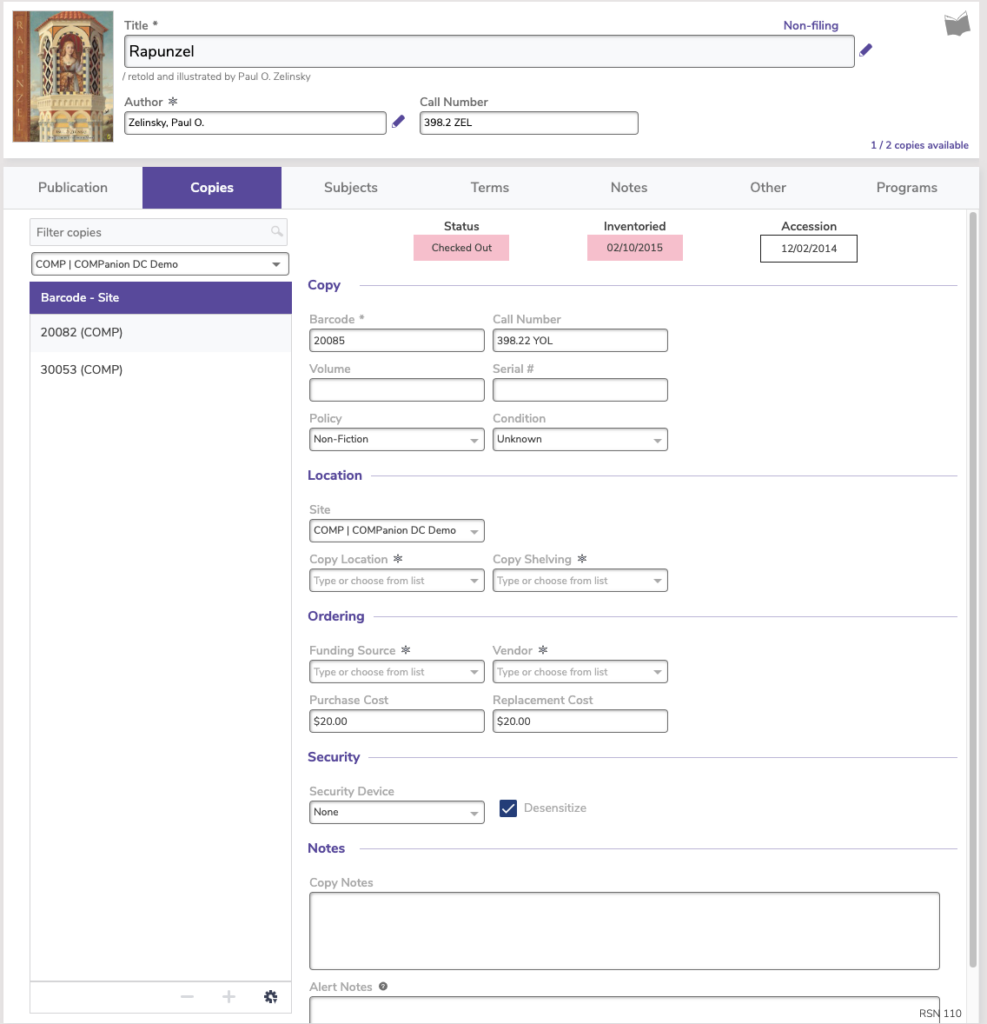
Site
Click the arrow to change the site you’re searching in. Each site is listed by the site code and name.
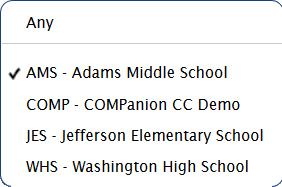
Copies’ Actions Menu
The Copies Actions Menu contains copy record-specific actions and other tools.
- Add Copy. This selection adds a new copy record to the title. Remember, new copies are part of the title record and will not be added until you click Save.
- Remove Copy. Selecting this option will remove the currently selected copy, regardless whether it is Lost or Available. This selection is only available when there are copies available in the Copies tab.
- Duplicate Copy. This duplicates the currently selected copy; duplicated copy records are provided a new Barcode depending on the Next Barcode setting in your Item Defaults preferences.
- Show Map. If the copy’s Call Number falls within the Call Number range of a corresponding map (created in Maps Management), selecting Show Map will display the map, detailing where the copy is located in your library. If the current copy lacks a Call Number (or there is no map with an associated call number range), the Show Map selection is disabled.
- Statistics. The Statistics dialog shows copy-specific circulation information; this information is used to help assess individual copy usage. It can be used for reference when ordering additional copies of items in high demand or weeding out infrequently used items. The information shown is a summary for all copies, and can not be modified.
- Transit History. This selection opens a dialog containing a summary of the copy’s interlibrary transit history for the last two years.
Add Copy
Once you have a valid title record saved, you can add your copy information.
Unlock the copy record by clicking the lock icon at the top of Items Management. Even if you unlocked Items earlier, you’ll still need to specifically unlock Copies.
To add a new copy to the title record:
- Log in to Items Management by adding /items to the end of your Alexandria URL.
- Use the basic or advanced search to locate the title you want to add this copy to.
- Make sure that the Copies tab is selected. Remember, copies are an extension of the title record; a copy cannot be selected unless the main title record exists or is saved.
- To add a new copy record to your title, click at the bottom of the copy Records List pane, or use the main button at the top and select Add Copy.
- The new copy record will be empty of all but your default values, some of which are required in order to save your new copy.
- Enter your new copy information and make changes to the copy record as needed.
- The Barcode is required to save your new copy; if you save with the field empty, it will default to your next starting barcode.
- The Call Number field will default from the title call number, so unless your copy call number differs from its title, you can leave it blank and let it default.
- When you have added all the necessary information for this copy, click the Save button to add your new copy to the title record, or click Revert to discard it.
Clicking Save button causes the new item to appear in the record list. You will be unable to select another record or leave the Items management module until you first Revert or Save your changes.
To add multiple copies quickly, use the Actions menu to Duplicate Copy instead.
Remove Copy
Items that have been discarded, given to other libraries, sold, or permanently lost should be routinely removed from your database to keep reports and searches from becoming cluttered with obsolete information. However, be absolutely certain that the copies you are about to remove should be permanently expunged from your collection.
For example, a lost item may eventually be found or later returned. In cases like these, it is better to record items as Lost, Discarded, On Repair, On Order, Archived, or Unknown. These special statuses (i.e. System Patrons) allow you to keep track of items that may eventually return to your library. Only remove copies that you know will never return to your collection.
To remove copies:
- Log in to Items Management by adding /items to the end of your Alexandria URL.
- Make sure that the Copies tab is selected.
- Go to the Actions menu at the bottom of the copy record list, and select Remove Copy to permanently remove the selected record.
- Copies that are checked out to the Lost, Discarded, On Repair, On Order, Archived, or Unknown System Patrons can be removed.
 | Removing a copy record is permanent and cannot be undone. If you remove a copy in error, you will have to re-enter the information or recover it from an archive of your data. If you need to report on copies that are Lost or Discarded for the year, you should check those copies out to the corresponding System Patrons. Run all necessary reports (statistics reports such as Super Summary, or Special Status Copies lists for budgeting and reporting) before removing these copies. Once they are removed, they are unavailable for any future reports. |
Subjects
The Subjects tab is where you can enter and modify subjects used to locate this item in your online catalog.
See also Item Editors, and learn all the great shortcuts in Hotkeys.
 | Every term in MARC subject fields are cataloged by Alexandria, searched by Researcher, and can be referenced in reports. |
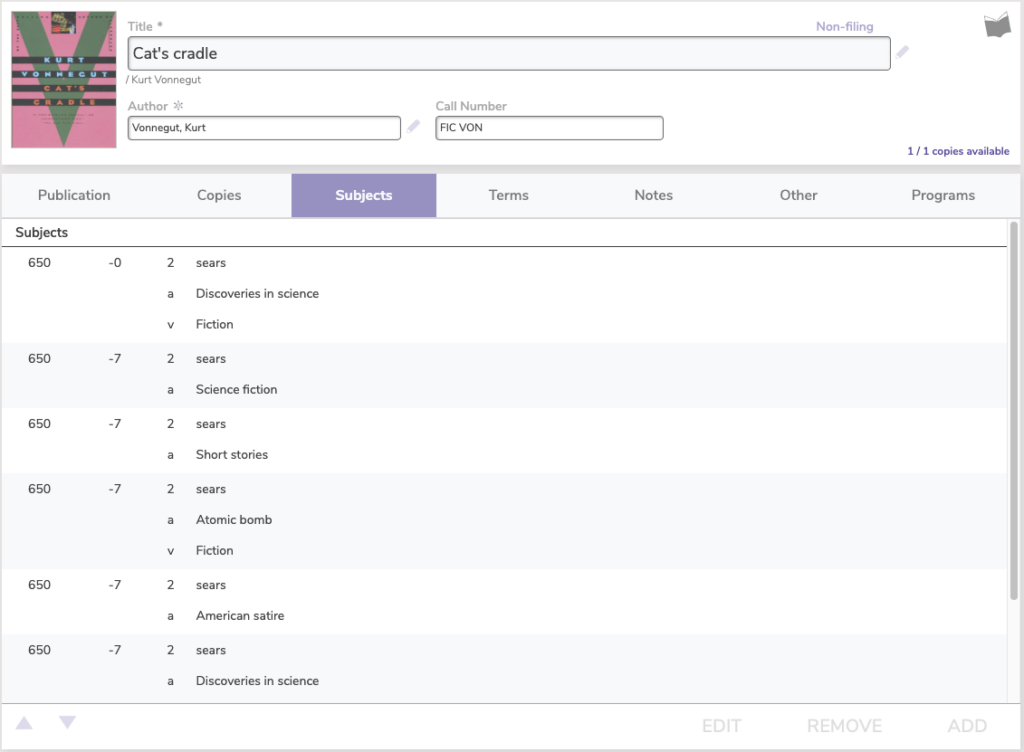
This is where you can add, edit, or remove MARC tags, indicators, and subfield data. Click the padlock icon to unlock the record for editing.
- Add. Opens the editor to add a new subject tag:
- 600 – Subject Added Entry – Personal Name
- 610 – Subject Added Entry – Corporate Name
- 611 – Subject Added Entry – Meeting Name
- 630 – Subject Added Entry – Uniform Title
- 650 – Subject Main Subject
- 651 – Subject Added Entry – Geographic Name
You can re-order records within the same tag numbers. For example, 650 tags can be moved higher or lower than another 650 tag, but they can’t be moved under 651 tags.
 | You can switch between title tabs (Publication, Subjects, Terms, Notes, Other, Study Programs) without losing your changes, but don’t forget to click the Save button in the header before you move to another title! |
Terms
This tab provides a way to group items into custom categories and searchable groups.
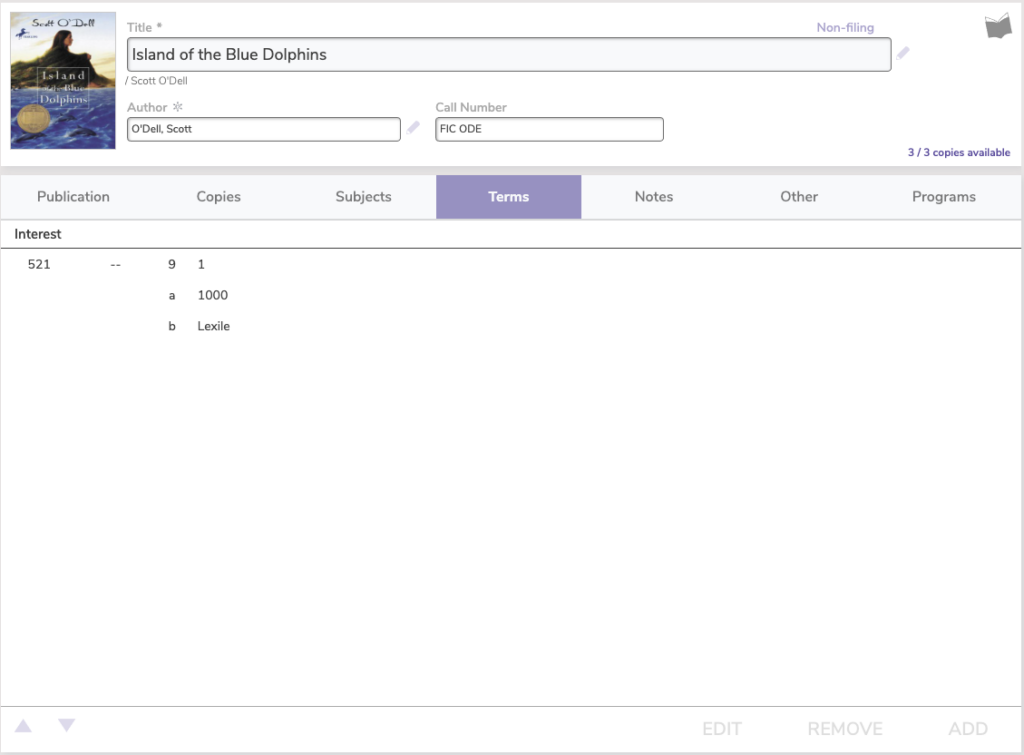
For example, say you want a way to quickly search for a group of books in Researcher. An easy way to do this would be to add a Bibliographic (653_a), Curriculum (658_a), or Interest Term (521_a) to the desired titles, and then use the Explore Builder to create a search pane and icon that performs the desired Bibliographic/Curriculum Term/Interest Level search. This allows you to guide your patrons to the recommended list (such as a makeshift “bibliography” created by the librarian per teacher’s request) of titles for specific projects or assignments.
When you add text to the categories in this window, patrons can search the text and find items in your collection. For example, you can create groups in the Curriculum Term column for a particular teacher’s class. You can then catalog the books for that class with that Curriculum Term value. When students search the curriculum group, the search results will display all books required for that teacher’s class.
- Bibliographic Term. Used to create bibliographies of interest to patrons. An item may belong to several different bibliographic categories. Bibliography data is saved in the MARC tag 653_a. This is also called an Index Term – Uncontrolled by the Library of Congress and is shown as that in the MARC View editor.
- Curriculum Term. Contains curriculum information for a title. For example, items that Mrs. Andres is using in her Geography 212 class can include curriculum categories such as “Geography 212” and “Mrs. Andres”. From an Alexandria Researcher, students can search for items by teacher or course name. Reports can be sorted by “curriculum”. The curriculum code data is stored in the MARC tag 658_a. This is also called a Index Term – Curriculum Objective by the Library of Congress and is shown as that in the MARC View editor.
- Interest Term. Contains information regarding the item’s intended audience. Be consistent in how you enter the values in this field and be sure your patrons know what values to search for (e.g. if you enter “8th grade” as an interest category, be sure your patrons know to enter “8th grade” rather than “Eighth Grade”)[1]. Interest level data is saved in MARC tag 521_a[2]. This is also called a Target Audience Note by the Library of Congress and is shown as that in the MARC View editor.
[1]↑ The interest code is not always so specific. Another example would be 7-10 (meaning age) or Junior High School to College Students.
[2]↑ Depending on the MARC indicator, it can be more specific. 521 00_a could be reading level [3.4]. 521 10_a could be interest age level [7-10]. 521 20_a could be interest grade level [K-3].
Notes
Notes is where you enter and modify summary, awards, and other ‘note’ type tags for this item.
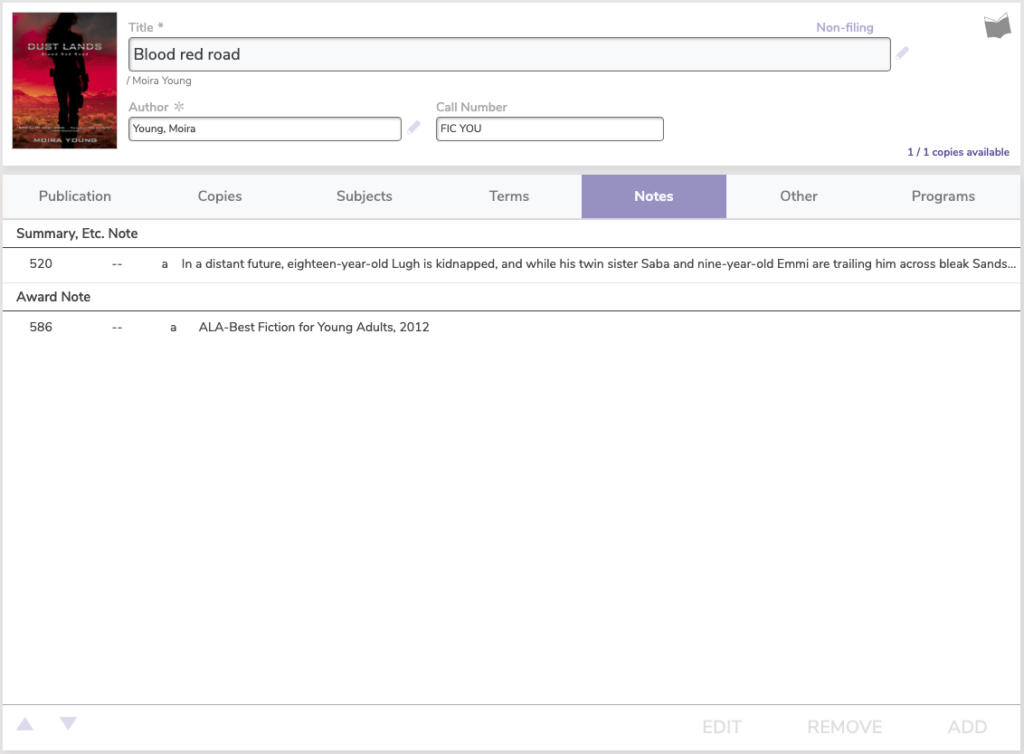
The Summary section allows you to input title summaries either manually or from information provided from the MARC record.
- 500 – General Note. Provide general information for this title; for example, general notes can read “Translated from Greek” or “Includes Index”. General notes are saved under MARC field 500_a.
- 505 – Formatted Contents Note. Provide title content notes. For example, content notes for an anthology may list the works included within the anthology. You can separate content notes by pressing the <return | enter> key after a content entry; this will automatically create the proper MARC content separator (in this case, <space> — <space>) in the MARC tag. Content notes are saved under MARC field 505_a.
- 520 – Summary, Etc. Note.
- 586 – Awards Note. Contains any award information for this title. Some examples of useful awards notes include “Caldecott Medal, 1979”, “National Book Award, 1981”, and “Pulitzer Prize for Nonfiction, 1981”. Awards notes are saved under MARC field 586_a.
Other
The Other subtab handles SIP2 magnetic medium settings and the ability to add, remove, or edit URLs attached to the title record. Links appear in the Results Details of the Alexandria Researcher when an item is found through a search. Your patrons can click on attachments to view or launch them from Results Details.
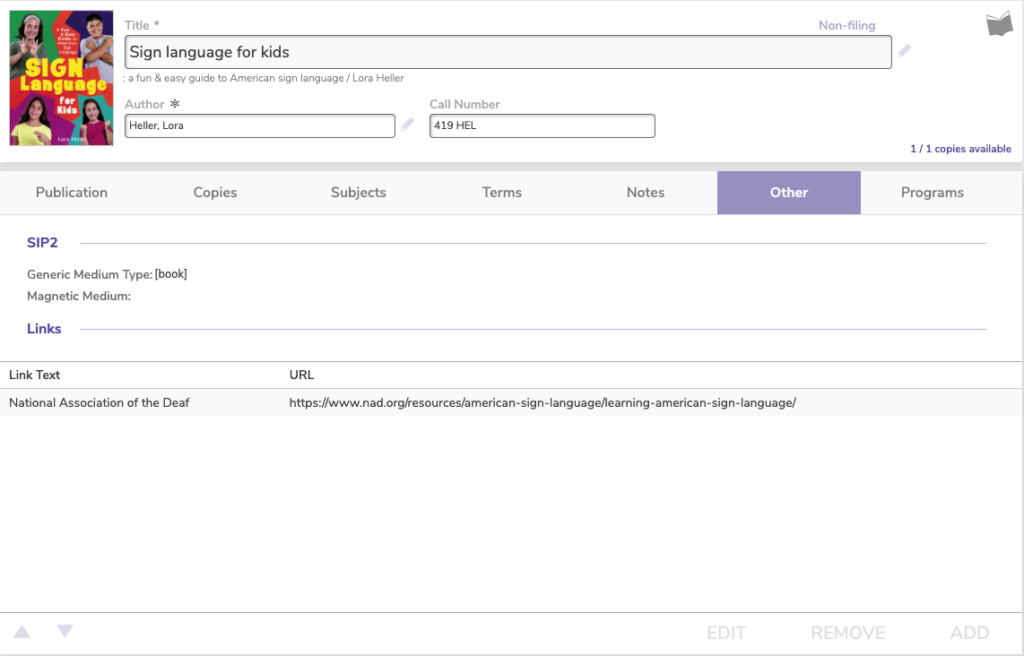
SIP2 Options
Generic Medium Type
If you already have a medium type specified from the primary information section of the Items Management window, the Generic Medium Type field will automatically try to match them by making an educated guess.
Magnetic Medium
This value indicates if the medium of this item is magnetic to prevent your security hardware from erasing the data contained within.
If the medium you have selected is usually a magnetic medium (e.g. a VHS tape or cassette tape), then the Magnetic Medium checkbox will automatically be checked. However, this can be further customized depending on the title. For example, if you have a medium type of Video Tape, and you’re applying it to a reel-to-reel film, you can uncheck the Magnetic Medium box because it can’t be demagnetized going through an automated desensitization security device.
Links
Add links to an online version of the item or other related information. For those who are MARC-savvy, links are stored in the 856 tag with _y being the link description and _u being the URL. Use the buttons at the bottom of the screen to add, remove, edit, or rearrange URLs in the list.
Select a link and then use the arrows to move it up or down within the list. Order matters! We recommend listing them in order of most to least relevant, because only the first link in the list will be displayed in Researcher search results, but you can, click View Links to see the rest of them.
- Add: Enter the complete URL (e.g. https://www.goalexandria.com/) and a link description (e.g. COMPanion Support Center) so your patrons know where it goes. You can make sure your link works by clicking Test, which will open the destination in a new tab. If it doesn’t work, check the URL and try again, or click Cancel.
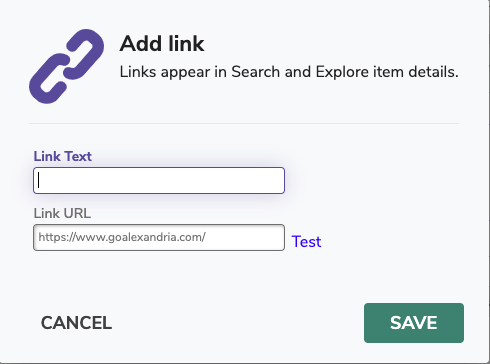
- Remove: Select the URL you would like to remove from the Links list and click Remove.
- Edit: Select the URL you would like to modify from the Links list and click Edit.
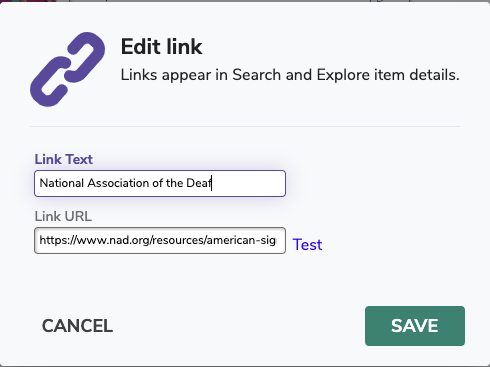
Programs
The Programs tab contains all of the study programs associated with this title. Selecting a study program from the the list will display its associated settings on the right. You may add multiple study programs for each title record, including programs of the same type.
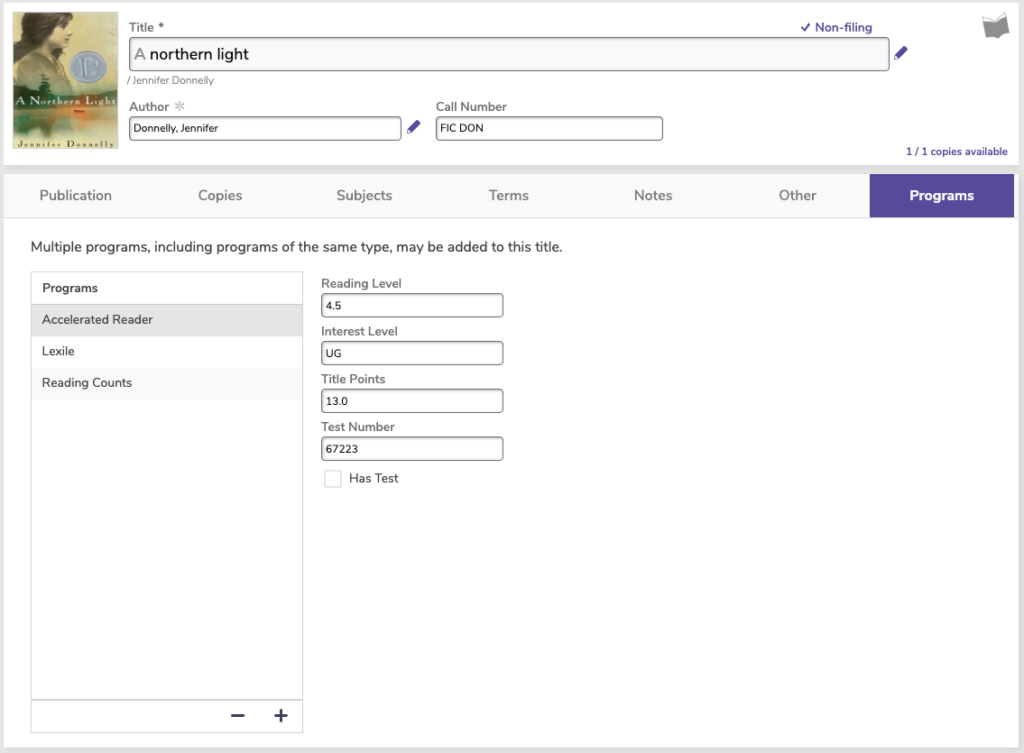
Study Program Settings
Select the study program you would like to add; doing so will create a new 521 or 526 MARC tag for the current title record.
The following terms are variations you can use in Alexandria.
| 1=Accelerated Reader | Accelerated Reader. | AR | AR. | Accelerated Reader AR | Accelerated Reader AR. |
| 2=Reading Counts | Reading Counts. | RC | RC. | Reading Counts! | Scholastic Reading Counts | Scholastic Reading Counts. | Scholastic Reading Counts! |
| 3=Fountas and Pinnell | Fountas and Pinnell. | Fountas & Pinnell | Fountas and Pinnell Leveled Books | Fountas and Pinnell Leveled Books. | Fountas & Pinnell Leveled Books | Fountas & Pinnell Leveled Books | F and P | F and P. | F & P | F & P. |
| 4=Guided Reading | Guided Reading. | GR | GR. | Guided Reading GR | Guided Reading GR. |
Interest Level
Reading Level
Reading Points
Test Number
Reading Counts
Interest Level
Reading Level
Reading Points
Test Number
Fountas and Pinnel
Interest Level
Guided Reading
Interest Level
Lexile
Alexandria allows you to import and export item Lexile measurements, regardless if Alexandria’s Lexile module has been licensed. Furthermore, even if you’re not licensed to use Alexandria’s Lexile module, you can apply an item Lexile measurement (0 – 2000) via the Lexile field in the Programs tab.
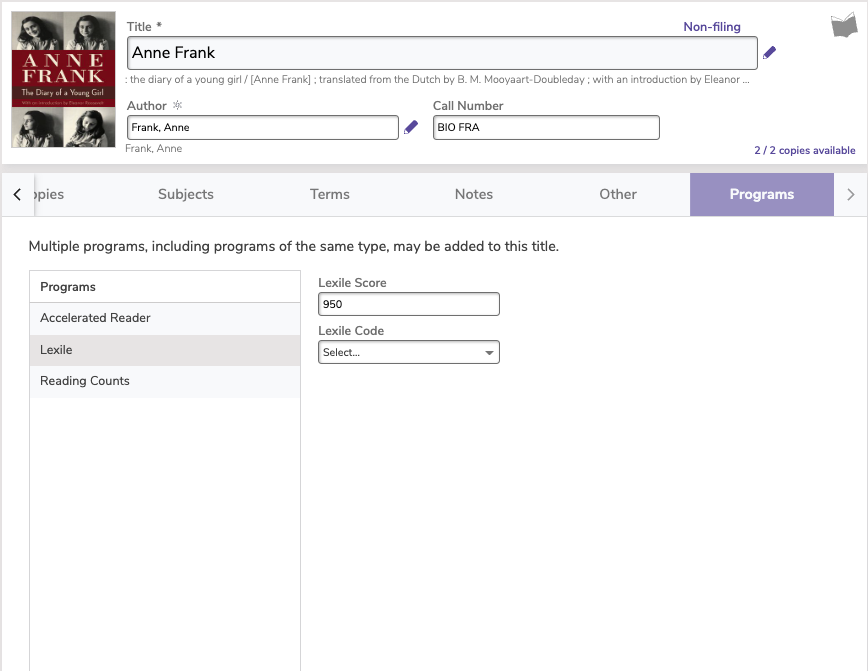
If a Lexile measurement has been applied to an item, and you are licensed to use the Alexandria Lexile module, it will be displayed in the Current Item section of the Circulation window.
As shown in the example below, the item has its Lexile measurement (860) displayed in Current Item pane of the Circulation window.
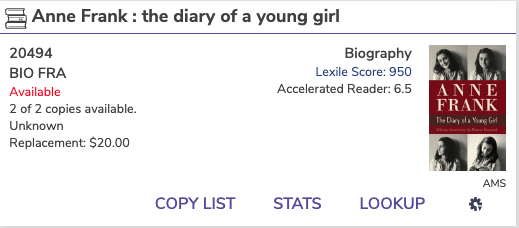
Examples of Study Programs in MARC 21 format:
| Accelerated Reader | Reading Counts | Fountas & Pinnell | Other |
|---|---|---|---|
| 526 0 _aAccelerated Reader_c1.9_d0.5_xPull for holiday viewing!_z1831._5CDL_91 | 526 0 _aReading Counts RC_b6-8_c6.2_d13._z365._5CDL_91 | 521 0 _aA-C_bFountas and Pinnell | 526 8 _aWinter Break Reading list. |
| 526 0 _aAccelerated Reader_c3.6_d0.5_z666_5LMS | 526 0 _aReading Counts_bK-2_c1.2_d1_5JMS | 521 0 _aA_bFountas and Pinnell | 526 8 _iOctober 2012 selection for:_aCOMPanion Reading Club. |
| 526 0 _aAccelerated Reader_c7.9_d25_z43 | 526 0 _aReading Counts_bK-2_c2.7_d2_z1201_5WMD | 521 0 _aQ_bFountas and Pinnell Leveled Books |
